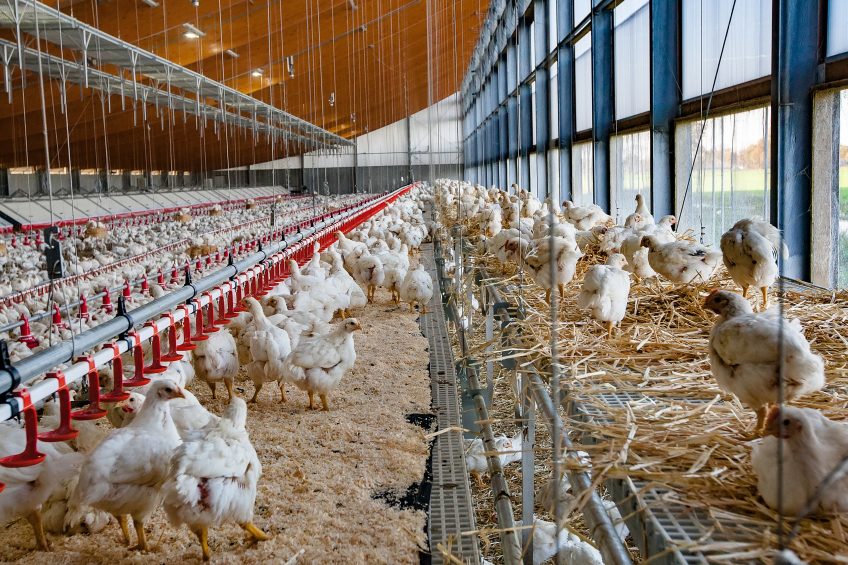Sustainability depends on viewpoint

Animal welfare and the CO2 footprint could conflict with one another. This is why the environmental efficiency of the Dutch poultry sector is not as high as theoretically possible. Nevertheless the Dutch poultry sector is known worldwide as sustainable.
Sustainability is a broad concept, including things like environmental impact, but also fair trade and animal welfare. The most commonly used definition of sustainability comes from the so called Brundtland report of the United Nations: sustainable development is the development which meets the current needs, without endangering the ability of future generations to supply their own needs.
The Food and Agriculture Organization (FAO) derived a definition from this for sustainable food patterns: “Sustainable food patterns have low impact on the environment and contribute to food safety and health for current and future generations. Sustainable food patterns are protective and respectful to biodiversity and ecosystems; culturally acceptable; accessible; economically fair and affordable; nutritionally adequate, secure and healthy.” The definition of the Dutch Ministry of Economics is: “Sustainable development is a development in which the current world population supplies their own needs without limiting future generations in their ability to supply their needs.”
In daily practice organisations and companies often approach sustainability from their own angle. According to environmental organisations keeping many chickens in a small space, results in ammonia emissions, particulate matter and over fertilisation. They also point at the adverse environmental consequences of feed production for poultry, such as deforestation and soil erosion in countries of origin like South Africa. Animal welfare organisations seek more attention for poultry housing. They think birds need more living space and a larger scratching area, beak-trimming ought to be prevented and slow growing strains should be used in meat production. Plus there are public health worries about the use of antibiotics in the livestock sector.
Poultry sector
The Dutch poultry sector is globally recognised as a frontrunner and example of innovation, efficiency and sustainability. However, there are regular discussions on what is the best way to produce sustainably. Often there are different perceptions of the importance of environmental and animal welfare; two elements of sustainability that conflict with each another.

In the poultry meat sector this is a current topic due to the large-scale move towards chicken concepts with slower growing strains for the domestic market. Poultry meat production therefore takes place in a tension field of animal welfare and environment. Besides fish, chicken has the most favourable CO2 footprint, as feed is converted into meat with high efficiency. Welfare-friendly concepts have less favourable footprints, due to slower growth, a lower occupancy per square metre or the free range area.
Laying hens
The situation in the laying industry resembles the situation of broilers. The environmental impact of eggs is caused by the emission of ammonia and particulate matter and the manure of chicken. Moreover, energy is needed in order to heat the houses and to produce feed. Plus land is needed in order to grow chicken feed. Animal welfare is important to assess the sustainability of eggs. For instance: how much living space does a bird have, can she take a dust bath and is an outdoor area available?

Also laying hens went through a large-scale move towards animal friendlier housing systems: the switch of cages to extensive indoor houses. This happened a longer time ago and went along with legal measures. In the broiler industry market developments led to a transition to concepts with more space per bird and slower growing strains.
Since 2012 traditional battery cages (‘regular cages’) have been prohibited in the EU. But birds can still be kept in – slightly spacier – cages (‘enriched cage’ or ‘colony’). Battery-cage eggs can also still be imported. Cage eggs have the lowest cost price and the lowest CO2 footprint or carbon footprint.
Footprint
The carbon footprint concerns refer to what extent production or company processes contribute to global warming. Whether the smallest footprint is the most sustainable depends on what definition of sustainable you use. Things become difficult if you consider animal welfare to be a part of sustainability. What is best for the animal is not always best for the environment.
At a recent gathering of the knowledge platform Poultry in ’s-Hertogenbosch, poultry farmer Léon Jansen from Schore said: “The poultry sector primarily focuses on animal welfare, and in my opinion not enough on footprint and circularity. This is a matter of time. Feed offers opportunities to lower the footprint. I would like to know what is the best way, how to prove this, and how to demonstrate this to the consumer.”

Louise O. Fresco, chair of the Board of Wageningen University & Research, also supports efficient food production and a rational approach. She emphasises that discussions about food production ought to be based on facts. “When it comes to sustainability of food, human intuition about healthy food is a poor counsellor just as food gurus,” said Fresco earlier this year in Leuven (B.). According to her animal welfare is a topic civilians approach emotionally. “One of the problems with meat is our irrational attitude to animal welfare. Westerners may not want animals to be slaughtered, but buy meat packages in the supermarket without giving it a thought.” Earlier Fresco said: “People don’t want to see the animal. Each chicken must be caressable. Humans are prone to cognitive dissonance.”
Catch-all term
The fact that social consensus about the poultry sector is not always based on rational arguments doesn’t make discussing sustainability of the poultry sector any easier. “Sustainability is a catch-all term. Dividing it up into three categories makes it a lot more intelligible. There is economic, social and environmental sustainability,” says Ellis Draaijer. ‘She is senior technical consultant poultry Benelux at Elanco Animal Health. “In the Netherlands a lot of pressure was put on the social side. This resulted in several types of concept chickens for the domestic market. The economic sustainability of these concept chickens seems to be quite good for now. It is a huge accomplishment that a large part of the poultry sector has made the transition to another approach in a few years’ time. But in terms of environmental sustainability concept chickens score less well than regular chicken,” Draaijer states.
Poultry economist Peter van Horne of Wageningen UR came to the same conclusion last year. “Regular broilers could be named environmental chicken. Regular broilers are most sustainable with the lower CO2 and ammonia emissions and the smallest ecological footprint. Let the consumer choose between an environmental chicken and an animal welfare chicken,” Van Horne says.
“Regular chicken currently scores poor in terms of social sustainability, but scores very well on the economic and environmental sustainability scale,” Draaijer emphasises. According to her the lack of social sustainability is mainly caused by the ignorance of the consumer. And that stings. “Add to that that a number of organisations and action groups have devoted themselves to distorting livestock farming. They do this for example by magnifying small excesses.”
Van Horne and Draaijer regret the fact that for Dutch consumers there is little freedom of choice left when purchasing chicken. Supermarkets no longer sell regular chicken, only concept chicken. Van Horne: “The consumer must be able to choose between an environmental chicken or an animal welfare chicken. Now, animal welfare organisation Wakker Dier is deciding for the society as a whole as to what is in the supermarkets. The environmental chicken is barely available anymore.”
No longer for sale
Draaijer: “The chicken I consider sustainable is no longer for sale in the supermarket. That is unfair.” If more rational arguments had been used in the last few years the broiler sector might have been different now, Draaijer suspects. “I can imagine one would have chosen chicken concepts that offer more space per bird, but still keep efficiently growing birds instead of slower growing strains. This is a lot better for the environment.” According to Draaijer there is no evidence that animal welfare is actually better for concept chickens than for regular broilers. “We do know that concepts are not necessarily better in terms of animal health, even though this is often suggested. Concept chickens don’t show health problems as well. However, necropsy reveals many gut health problems.”
Don’t go to extremes
Draaijer hopes poultry meat production will not go to extremes when it comes to barely or unfounded animal welfare assumptions and limited freedom of choice. It is important that the sector continues to pursue wide-ranging sustainability, taking animal welfare into account just as much as environment and economics. “This is thinking in boxes. In the Netherlands we have the luxury of always having enough food on the table. But we are part of a larger world, in which resources and space are scarce and many people do not have enough food to eat.”
The future of coccidiostats in feed is a regularly discussed topic. “There are no strong arguments not to use these resources. They don’t involve the resistance problems around antibiotics used in human health care. On the contrary, coccidiostats contribute to the reduction of antibiotics and have a positive impact on gut health and foot pad lesions, which are important welfare indicators.”













